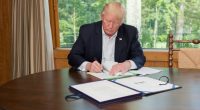Minze Chien, President of FAPA
Sunday last week marked the 42nd anniversary of the enactment of the Taiwan Relations Act (TRA). The act was signed by then-US president Jimmy Carter on April 10, 1979, after passing both chambers of the US Congress to ensure that the US’ “commercial, cultural and other relations” with Taiwan would continue smoothly despite Washington’s decision to recognize the People’s Republic of China over the Republic of China.
Congress at the time insisted that the act be drafted “to help maintain peace, security and stability in the western Pacific and to promote the foreign policy of the United States by authorizing the continuation of commercial, cultural and other relations between the people of the United States and the people on Taiwan, and for other purposes.”
In 1982, then-US president Ronald Reagan, fearing that the Carter administration had overlooked many explicit security commitments to Taiwan, which Congress enumerated in the TRA, promulgated new instructions on US policy toward Taiwan.
These “six assurances” were augmented in a Reagan memo to the secretaries of state and defense on Aug. 17, 1982. It declared that the US’ defense commitment and arms sales to Taiwan are “conditioned absolutely upon the continued commitment of China to the peaceful solution of the Taiwan-PRC differences.”
Last year, the US declassified this once-secret memo together with the full texts of the “six assurances.”
Today, the TRA and the “six assurances” form the cornerstones of US-Taiwan relations.
For four decades, the act has been the law of the land and the “six assurances” have been reaffirmed by every successive US presidential administration since Reagan, but much has changed in 40 years.
When the TRA was enacted, Taiwan was still under martial law and ruled by the authoritarian Chinese Nationalist Party (KMT). More than 140,000 Taiwanese were imprisoned during the nearly 40-year period of martial law from 1949 to 1987.
Over the past decades, Taiwan has evolved into a vibrant democracy, having peacefully transitioned power several times between political parties. The country stands as a progressive beacon of democracy for others in the region to emulate.
Yet the TRA has been frozen in time, never amended and never extended.
There is a consensus in Washington that the TRA should not be amended or that it should not be opened up. Doing so would give all elements — friendly and hostile — opportunities to muddle and detract from the law, which, after all, does indeed treat Taiwan as a “country” or a “state” distinct from China. What more is needed?
Do the US’ new strategic realities in the western Pacific demand a new law that preserves the full TRA and enshrines in it some of the “six assurances,” as well as elements of recent pro-Taiwan legislation passed in the past three years, even incorporating language of pending congressional bills?
Exactly what new components might a new “TRA 2.0” as an addendum to the 1979 TRA contain as a US law that reflects the relationship between the US and Taiwan of this day and age?
First, the law could codify several of the “six assurances” — especially the ones that prohibit the executive branch from ever consulting with China on arms sales to Taiwan, playing a mediation role between Taipei and Beijing, or exerting any pressure or influence on Taiwan to enter into negotiations with China.
Surely, these already are consistent with the TRA, but past US administrations have pushed the boundaries of the act.
Second, a “TRA 2.0” should more clearly define the US commitment to Taiwan’s defense. The policy of “strategic ambiguity” no longer suffices. With daily and ever-escalating Chinese incursions into Taiwan’s air defense identification zone (ADIZ) over the Taiwan Strait and East China Sea the time for “strategic clarity” is now.
Third, a “TRA 2.0” might consolidate and reinforce some important elements of pro-Taiwan legislation efforts passed or introduced over the past few years.
These efforts would include: the Taiwan Travel Act of 2018, which allows high-level Taiwan and US officials to make corresponding visits; the Taiwan Allies International Protection and Enhancement Initiative Act of 2019, which was designed to bolster Taiwan’s diplomatic status and participation in international organizations; the Taiwan Assurance Act of 2019, which promotes arms sales to Taiwan and its participation in international organizations; the reassurance for official contacts act, introduced last month, which allows Taiwanese diplomats and service members to display their flag and wear their uniforms while on official business; and the Taiwan relations reinforcement act, also introduced last month, which aims to improved military-to-military cooperation, prioritize trade agreement negotiations, and require the director of the American Institute in Taiwan to be confirmed by the US Senate.
While a “TRA 2.0” is being contemplated, Chinese bombers are entering Taiwan’s ADIZ in increasing numbers and with increasing frequency. For believing in democracy, Taiwanese continue to suffer under their neighbor’s bullying and intimidation.
So far, the US has not formally recognized Taiwan’s statehood. Taiwanese Americans dream of the day the US will officially and diplomatically recognize Taiwan as an independent sovereign state.
By enacting a “TRA 2.0,” the US would reaffirm Taiwan’s dedication to democracy, and announce to the world that Taiwan has the right to exist and must be free from outside intimidation and interference.


